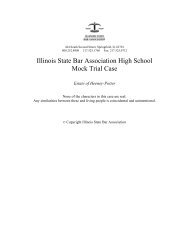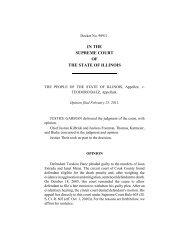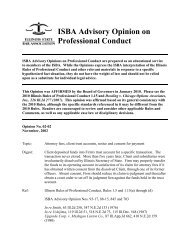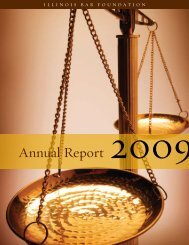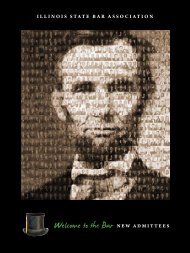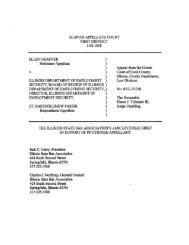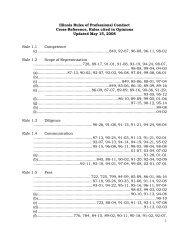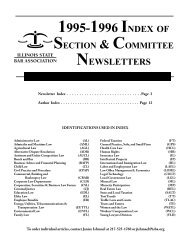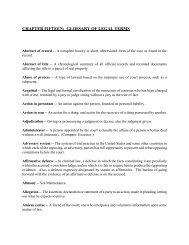MOTIONS TO DISMISS PURSUANT TO 735 ILCS 5/2-615 AND 2-619
MOTIONS TO DISMISS PURSUANT TO 735 ILCS 5/2-615 AND 2-619
MOTIONS TO DISMISS PURSUANT TO 735 ILCS 5/2-615 AND 2-619
You also want an ePaper? Increase the reach of your titles
YUMPU automatically turns print PDFs into web optimized ePapers that Google loves.
2. Distinguished From Section 2-<strong>615</strong> Motions To Dismiss<br />
A 2-<strong>619</strong> motion can be distinguished from a 2-<strong>615</strong> motion in that a motion to dismiss under<br />
<strong>735</strong> <strong>ILCS</strong> 5/2-<strong>615</strong> attacks only the legal sufficiency of the complaint and does not raise affirmative<br />
factual defenses, as does a motion under 2-<strong>619</strong>. Urbaitis v. Commonwealth Edison, 143 Ill. 2d<br />
458, 575 N E 2d 548 (1991).<br />
=======================================================<br />
PRACTICE TIP: “So What” Motions vs. “Yes, But” Motions<br />
In Winters v. Wangler, 386 Ill. App. 3d 788, 898 N.E.2d 776 (4th Dist. 2008)<br />
and Barbar-Colman Co. v. A&K Midwest Insulation Co., 236 Ill. App.3d<br />
1065, 603 N.E.2d 1215 (4th Dist. 1992), the courts outline the differences<br />
between dispositive motions under Sections 2-<strong>615</strong>, 2-<strong>619</strong> and 2-1005. The<br />
Winters court explains that 2-<strong>619</strong> motions are sometimes called “Yes, But”<br />
motions because the defendant is saying “Yes, the complaint was legally<br />
sufficient, but an affirmative matter exists that defeats the claim.” By<br />
contrast, the court explains that 2-<strong>615</strong> motions are sometimes called “So<br />
What” motions because the defendant is saying “So what The facts the<br />
plaintiff has pleaded do not state a cause of action against me.”<br />
=======================================================<br />
3. Distinguished From Section 2-1005 Summary Judgment Motions<br />
Although similar to a summary judgment motion, a section 2-<strong>619</strong> motion differs in that the<br />
court may, in its discretion, decide questions of fact “upon the hearing of the motion.” Consumer<br />
Electric Co. v. Cobelcomex, Inc., 149 Ill. App. 3d 699, 703, 501 N.E.2d 156, 159 (1 st Dist. 1986).<br />
See also Barbar-Colman Co. v. A&K Midwest Insulation Co., 236 Ill. App.3d 1065, 603 N.E.2d<br />
1215 (4th Dist. 1992) (listing five key differences between 2-<strong>619</strong> and 2-1005 motions).<br />
4. Affidavits And Other Evidence In Support Of 2-<strong>619</strong> Motion<br />
Affidavits filed in support of Section 2-<strong>619</strong> motions are controlled by Illinois Supreme<br />
Court Rule 191. Elliot v. LRSL Enterprises, Inc., 226 Ill. App. 3d 724, 589 N.E.2d 1074 (2d Dist.<br />
1992). Rule 191(a) should be construed according to the plain and ordinary meaning of its<br />
language. Its requirements should be adhered to as written, Ribidoux v. Oliphant, 201 Ill. 2d 324,<br />
337, 775 N. E. 2d 987 (2002), citing Bright v. Dicke, 166 Ill. 2d 204, 210. 652 N. E. 2d 275<br />
(1995). An affidavit will be stricken if it does not have attached sworn or certified copies of all<br />
papers upon which the affiant relied, Robidoux, 201 Ill. 2d at 343, 775 N. E. 2d 987.<br />
Although the statute speaks only of supporting a 2-<strong>619</strong> motion with affidavits, other<br />
evidence may also be submitted in support of the motion. Fremont Comp. Ins. Co. v. Ace Chicago<br />
Great Dane Corp., 304 Ill. App. 3d 734, 710 N.E.2d 132 (1 st Dist. 1999). Urban v. Loham, 227 Ill.<br />
App. 3d 772, 592 N.E.2d 292 (1 st Dist. 1992).<br />
8



